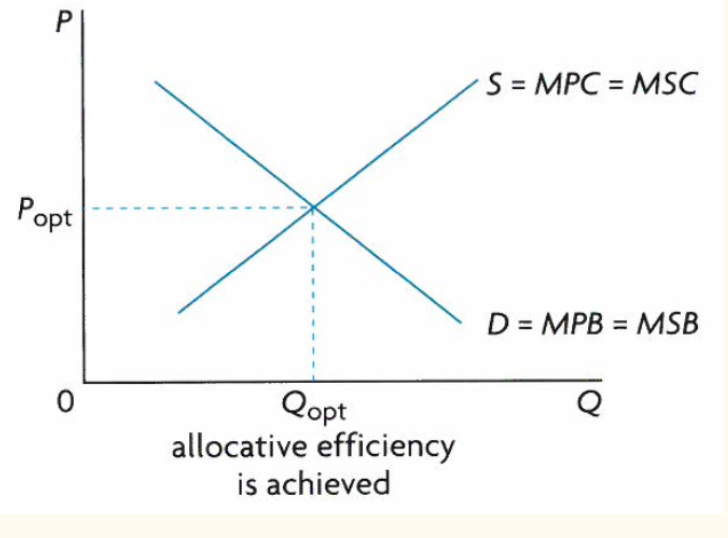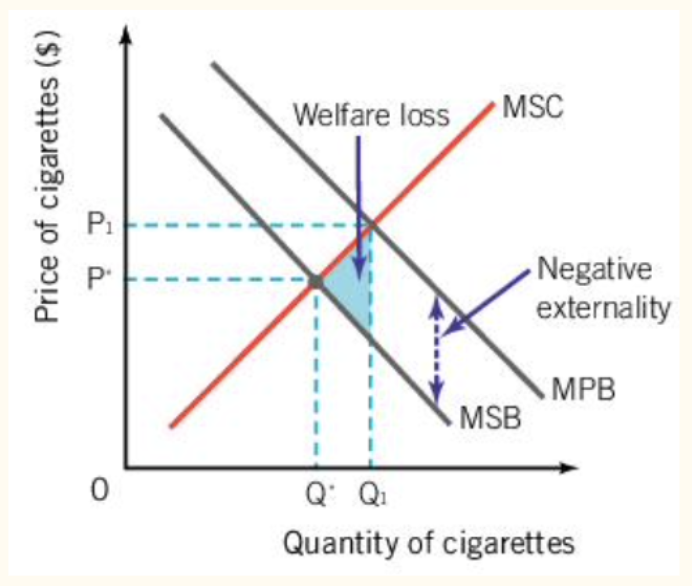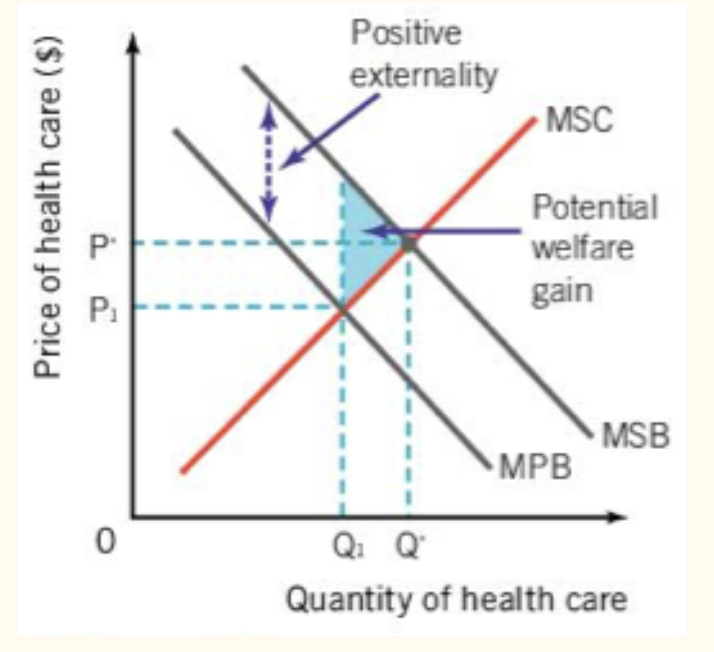Market Failure 2-8-2.10 Microeconomcs
1/76
Earn XP
Description and Tags
Name | Mastery | Learn | Test | Matching | Spaced |
|---|
No study sessions yet.
77 Terms
Markets are efficient because, when in equilibrium, they are
allocativelly efficient
When governments intervene in free markets (indirect taxes, subsidies, price controls), resources become misallocated and there
is a loss of total welfare
Market failure refers to the market’s inability to
allocate resources efficiently
markets themselves may not be
naturally efficient
both consumers and producers do not always act in a
rational or efficient way
government intervention may be necessary in a market to
maximize marginal social benefit (MSB)
government intervention can help improve
community surplus and allocative efficiency
an externality is
an effect on a third party resulting from consumption/production of a good or service
harmful effects are known as
negative externalities
beneficial effects are known as
positive externalities
marginal social cost (MSC)
refers to the cost to society of producing one additional unit of good
marginal private benefit (MPB)
refers to the cost to producers producing one additional unit of a good
marginal social benefit (MSB)
refers to the benefits to society from consuming one additional unit of a good
marginal private benefit (MPB)
refers to the benefits to consumers from consuming one additional unit of a good
if no externalities exist,
then MSC=MSB and maximum community surplus exists (allocative efficiency)

this diagram displays
there are no externalities of production or consumption
when externalities do occur there are 4 types
Negative externalities of consumption
Negative externalities of production
Positive externalities of consumption
Positive externalities of production

this is a
negative externality of consumption
negative externalities of consumption are when
an individual’s consumption adversly affects third parties (often through demerit goods)
examples of negative consumption externalities are
cigarette smoking (second hand smoke, use of healthcare to treat smoking related health issues)
alcohol consumption (drunk driving, domestic violence)
car driiing (car exhausts create pollution)
when MPB exceeds the MSB—individuals gain more benefits from consumption than society this is a
negative consumption externality
when the MPB curve lies to the right of the MSB curve on a negative consumption externality it creates
welfare loss
in negative consumption externalities, the social cost of individual consumption is higher than
the socially optimal level of consumption
welfare loss in real terms represents
The costs paid by/damage to society for individual consumption of the good or service
there are four ways negative externalities of consumption can be reduced or eliminated
Indirect taxes (affects MSC curve)
Legislation/regulation (may affect MSC or MPB curve)
Education/increasing awareness (affects MPB curve)
“Nudges” (HL ONLY; affects MPB curve)
Indirect taxes (affects MSC curve)
Taxes can raise revenue for the government and discourage consumption (remember, elasticity can affect efficacy of indirect taxes)
Indirect taxes are regressive (takes up a larger proportion of income from lower income individuals)
Higher prices and costs for consumers and producers; can create unemployment
Legislation/regulation (may affect MSC or MPB curve)
Laws may be passed to reduce consumption
Regulation may be difficult or costly to enforce
Banning may lead to parallel or black markets
Education/increasing awareness (affects MPB curve)
Advertising or public awareness campaigns can encourage reduced consumption of demerit goods
May be costly and efficacy may be questionable
“Nudges” (HL ONLY; affects MPB curve)
Strategies with the goal of encouraging reduced consumption voluntarily and without taking away the freedom to choose
Example: Cigarette packages plainly decorated, or decorated with shocking images of the effects of smoking
Negative Externalities of Production are when there is
production that adversely affects third parties
negative externalities of production are often associated with
common pool resources
examples of negative externalities of production are
energy production or manufacturing that causes enviromental damage (air/soil/water/pollution)
Overfishing
in a negative externality of production the MSC exceeds the MPC resulting in
producers gaining more benefit from production than society
in negative externalities of production, the MPC curve lies to
the right of the MSC curve and this creates welfare loss
with negative externalities of production society
bears the greater cost of production than the producer
common pool resources also known as “gifts of nature” have no
private ownership and way to regulate use of the resource
examples of common pool resources are
fish in the sea
trees in the forest
common pastureland
fresh water in aquifers or in rivers
overuse of common pool resources is based on
the tragedy of the commons
the tragedy of the commons is when the
Lack of ownership over the resources creates an incentive for potential users to exploit them to the fullest extent possible,
to extract as much benefit as possible before other users extract and exploit the resource
negative externalities of production can be reduced or eliminated by three ideas
Producer taxes (affects MPC curve)
Tradable Permits (affects MPC curve on NEP diagram)
Legislation and Regulation (“command and control” solutions)
Producer taxes (affects MPC curve)
Increases MPC of producers in order to reduce welfare loss and a more socially optimal level of production, but results in higher prices, lower quantity supplied, and increased unemployment
Example: Carbon taxes
Tradable Permits (affects MPC curve on NEP diagram)
Government sets number of permits and these are auctioned off
Some firms pollute more than others, so they must buy surplus permits from others
Creates incentive to reduce pollution because polluting more becomes more expensive, and polluting less allows them to sell surplus permits, thereby making a profit
Legislation and Regulation (“command and control” solutions)
Examples include laws, bans, regulatory standards & controls, government management, international agreements, privatization, subsidies, etc.
Can affect MPC or MSB curves
the advantage of tradeable permits is it
Creates a strong incentive to pollute less and a clear price and allowable quantity of pollution
this disadvantages of tradeable permits are
Free market price of permits may be too low to create an incentive to pollute less
Costly and difficult to monitor
the advantages of legislation and regulation is it
Can reduce negative production externalities and reduce pollution, conserve wildlife, make the population healthier, etc.
the disadvantages of legislations and regulations are
Can be costly and difficult to enforce
Can raise prices and harm industry competitiveness
Often subject to special interest lobbying (regulatory capture)
Can lead to over-regulation and inefficiency

this is a§
positive externality of consumption
positive externalities of consumption are when
consumption has spillover benefit on third parties (often society as a whole)
in positive externalities of consumption the MSB
exceeds the MPB—society gains more benefit from consumption than the individual
in a positive consumption externality the MSB curve lies
to the right of the MPB curve and creates potential welfare
positive externalities of consumption are often associated with
merit goods
examples of positive externalities
Education
Public Heath Care
positive externalities of consumption can occur through 3 ways
Subsidies (affects MSC curve)
Advertising/public awareness campaigns (affects MPB curve)
Legislation (affects MPB curve)
Subsidies (affects MSC curve)
Subsidies can be granted to producers to encourage production of a beneficial good or service, or to consumers to encourage consumption
E.g., Educational grants for students or educational institutions
Subsidies always come with an opportunity cost!
Advertising/public awareness campaigns (affects MPB curve)
Encourage public consumption of goods or services (e.g., public health campaigns)
Legislation (affects MPB curve)
Often includes mandatory consumption (e.g., compulsory education)
positive externalities of production are when
production has a spillover benefit on third parties (often society as a whole)
in positive externalities of production the MPC
exceeds the MSC society gains more benefit from production than the producer
in positive externalities of production the MPC curve
lies to the left of the MSC curve, the producer pays a higher cost, and society reaps the benefit
the examples of positive externalities of production are
Fruit orchards (increased honey production)
The Nabisco cookie factory in Fair Lawn, NJ
Open source software
On-the-job training
Ecotourism
positive externalities of production can occur from two ways
Subsidies (affects MPC curve)
Direct provision by government (affects MPC curve)
Example: Government can provide work training programs
for positive externality graphs the welfare gain triangle points to the
right
for negative externality graphs the welfare gain triangle points to the
left
production externality diagrams have two
cost/supply curves
consumption externality diagrams gave two
demand/benefit curves
if a market produces none of a good it is considered a
public good
public goods are
Non-rivalrous (enjoyment by one consumer does not diminish other consumers’ enjoyment of the same good)
Non-excludable (it is impossible to exclude individuals from enjoying its benefits)
Subject to the free-rider problem because of these characteristics--people will gain benefit from it without paying for it, and that is why the good is not provided by the free market and hence a type of market failure (no profit can be made!)
examples of common public goods are
Public parks & trash disposal
Lighthouses & street lights
Fire & police services
there are no purely public except for maybe
public national defense
there are some goods provided by the government that have public good characteristics such as
roads
legal systems
education
whether a good is more private or public depends on the degree of
excludability and rivalry in consumption
public goods are provided through
Government (direct) provision using taxpayer money
Public goods such as emergency services, national defense, and infrastructure (sewer systems, street lighting, public parks, etc.)
Public-private partnerships
Governments provide funds to create the good, then a private company manages it
Examples include railroads, toll roads, power infrastructure, etc.
“Quasi-public goods” have some but not all characteristics of public goods
E.g., a park bench is free to use for everyone, but it is partly rivalrous and excludable (only so many people can fit on the bench)
Public parks/spaces, roads, and highways may be considered quasi-public goods
no participants in the market have
perfect information or perfect knowledge
The most common example of imperfect information is
asymmetric information--when one party has more or better information than others
Example: Mr. Winters sells Mr. Helke a “lemon” (a car that is likely to break). Mr. Winters knows the car is faulty, but Mr. Helke doesn’t. Mr Helke thinks the car is a good deal and buys it, only to have it break the next week.
Adverse Selection is when
One party in an economic transaction has better information than the other, resulting in poor choices
often occurs before the economic transaction is made
Example: Health insurance customers being dishonest about their health leads to higher insurance premiums for all buyers of health insurance; as a result, fewer people purchase health insurance (which can result in negative externalities on society)
Moral Hazard Occurs when
people have an incentive to engage in riskier behavior because they know that the negative consequences of their risks are more likely to be borne by others
Often occurs after an economic transaction has been made
Example: I buy full insurance on a rental car, and then drive carelessly; any damage I incur will be covered by the insurance I purchased